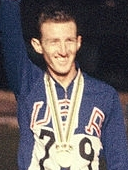Lekkoatletyka na Letnich Igrzyskach Olimpijskich 1964 – bieg na 5000 m mężczyzn
 Podium medalistów. Od lewej: Harald Norpoth, Bob Schul i William Dellinger | |
Bieg na 5000 metrów mężczyzn podczas XVIII Letnich Igrzysk Olimpijskich w Tokio rozegrano 16 (eliminacje) i 18 października 1964 (finał) na Stadionie Olimpijskim w Tokio. Zwycięzcą został Amerykanin Bob Schul.
Rekordy
| zawodnik | narodowość | czas | data | miejsce | |
|---|---|---|---|---|---|
| Rekord świata | Wołodymyr Kuc | 13:35,0 | 13 października 1957(dts) | Rzym[1] | |
| Rekord olimpijski | 13:39,6 | 28 listopada 1956(dts) | Melbourne[2] |
Wyniki
| Poz. - pozycja |
| Fn – falstart | DNF – nie ukończył | DNS – nie wystartował | DSQ – zdyskwalifikowany |
Eliminacje
Rozegrano cztery biegi eliminacyjne. Do finału awansowało po trzech najlepszych zawodników z każdego biegu.
Bieg 1
| Poz. | Zawodnik | Narodowość | Rezultat | Uwagi |
|---|---|---|---|---|
| 1 | Michel Jazy | 13:55,4 | Q | |
| 2 | Bill Baillie | 13:55,4 | Q | |
| 3 | Stepan Bajdiuk | 14:00,2 | Q | |
| 4 | Andrei Barabaș | 14:00,2 | ||
| 5 | Tony Cook | 14:02,2 | ||
| 6 | John Herring | 14:07,2 | ||
| 7 | Muharrem Dalkılıç | 14:12,0 | ||
| 8 | Lutz Philipp | 14:15,2 | ||
| 9 | Bruce Kidd | 14:21,8 | ||
| 10 | János Pintér | 14:41,0 | ||
| 11 | Jean Randrianjatavo | 15:50,4 | ||
| – | Gaston Roelants | DNS | ||
| – | Pascal Mfyomi | DNS |
Bieg 2
| Poz. | Zawodnik | Narodowość | Rezultat | Uwagi |
|---|---|---|---|---|
| 1 | Mike Wiggs | 13:51,0 | Q | |
| 2 | William Dellinger | 13:52,2 | Q | |
| 3 | Thor Helland | 13:52,4 | Q | |
| 4 | Lech Boguszewicz | 13:52,8 | ||
| 5 | Kęstutis Orentas | 13:54,0 | ||
| 6 | Eugène Allonsius | 13:55,0 | ||
| 7 | Jean Vaillant | 14:05,8 | ||
| 8 | Manfred Letzerich | 14:06:2 | ||
| 9 | Tom O’Riordan | 14:08,8 | ||
| 10 | Aske Dam | 14:20,4 | ||
| 11 | Albie Thomas | 14:27,8 | ||
| 12 | Fernando Aguilar | 14:29,2 | ||
| 13 | Álvaro Mejía | 14:41,4 | ||
| – | Ebrahim Yazdan Panah | DNS |
Bieg 3
| Poz. | Zawodnik | Narodowość | Rezultat | Uwagi |
|---|---|---|---|---|
| 1 | Mohammed Gammoudi | 14:10,2 | Q | |
| 2 | Bob Schul | 14:11,4 | Q | |
| 3 | Harald Norpoth | 14:11,6 | Q | |
| 4 | Murray Halberg | 14:12,0 | ||
| 5 | Josef Tomáš | 14:12,6 | ||
| 6 | Bengt Nåjde | 14:13,4 | ||
| 7 | Franc Červan | 14:16,6 | ||
| 8 | Simo Saloranta | 14:24,6 | ||
| 9 | Lajos Mecser | 14:35,4 | ||
| 10 | Jean Fayolle | 14:44,6 | ||
| 11 | Somsak Keaokanta | 16:08,8 | ||
| 12 | Ranatunge Karunananda | 16:22,2 | ||
| 13 | Nguyễn Văn Lý | 17:28,0 |
Bieg 4
| Poz. | Zawodnik | Narodowość | Rezultat | Uwagi |
|---|---|---|---|---|
| 1 | Ron Clarke | 13:48,4 | Q | |
| 2 | Kipchoge Keino | 13:49,6 | Q | |
| 3 | Nikołaj Dutow | 13:50,6 | Q | |
| 4 | Francisco Aritmendi | 14:05,0 | ||
| 5 | Sven-Olov Larsson | 14:10,2 | ||
| 6 | Satsuo Iwashita | 14:18,4 | ||
| 7 | Derek Graham | 14:21,6 | ||
| 8 | Oscar Moore | 14:24,0 | ||
| 9 | Simo Važić | 14:33,8 | ||
| 10 | Henri Clerckx | 14:40,0 | ||
| 11 | Neville Scott | 15:01,0 | ||
| – | Ben Assou El Ghazi | DNS | ||
| – | Manuel de Oliveira | DNS | ||
| – | Mamo Wolde | DNS |
Finał
| Poz. | Zawodnik | Narodowość | Rezultat | Uwagi |
|---|---|---|---|---|
| 1 | Bob Schul | 13:48,8 | ||
| 2 | Harald Norpoth | 13:49,6 | ||
| 3 | William Dellinger | 13:49,8 | ||
| 4 | Michel Jazy | 13:49,8 | ||
| 5 | Kipchoge Keino | 13:50,4 | ||
| 6 | Bill Baillie | 13:51,0 | ||
| 7 | Nikołaj Dutow | 13:53,8 | ||
| 8 | Thor Helland | 13:57,0 | ||
| 9 | Ron Clarke | 13:58,0 | ||
| 10 | Stepan Bajdiuk | 14:11,2 | ||
| 11 | Mike Wiggs | 14:20,8 | ||
| – | Mohammed Gammoudi | DNS |
Przypisy
- ↑ Progression of IAAF World Records. 2015 Edition, IAAF, 2015, s. 87 [dostęp 2020-08-28] (ang.).
- ↑ Mark Butler (red.): IAAF Statistics Handbook Special Edition. Games of the XXXI Olympiad Rio 2016. IAAF, 2016, s. 104. [dostęp 2020-08-28]. (ang.)
- ↑ Janusz Waśko, John Brant, Györgyi Csiki, Andrzej Socha: Golden Century of IAAF Records. National Records Evolution 1912-2012. Zamość: 2013, s. 54. ISBN 978-83-62033-30-0. (ang.)
Bibliografia
- Games of the XVIII Olympiad, Tokyo 1964 : the official report of the Organizing Committee, v.2, library.la94.org, s. 31–32 [dostęp 2020-08-28] (ang.).
- Athletics at the 1964 Tokyo Summer Games: 5000 metres, Men, olympedia.org [dostęp 2020-08-28] (ang.).
Media użyte na tej stronie
An icon that represents a gold medal
The flag of Navassa Island is simply the United States flag. It does not have a "local" flag or "unofficial" flag; it is an uninhabited island. The version with a profile view was based on Flags of the World and as a fictional design has no status warranting a place on any Wiki. It was made up by a random person with no connection to the island, it has never flown on the island, and it has never received any sort of recognition or validation by any authority. The person quoted on that page has no authority to bestow a flag, "unofficial" or otherwise, on the island.
An icon that represents a silver medal
An icon that represents a bronze medal
Sport records icon to be used for national records.
Sport records icon to be used for personal best marks.
Sport records icon to be used for Olympic records.
Flag of New Zealand. Specification: http://www.mch.govt.nz/nzflag/description.html , quoting New Zealand Gazette, 27 June 1902.
Autor: SanchoPanzaXXI, Licencja: CC BY-SA 4.0
Flag of Spain during the Spanish State. It was adopted on 11 October 1945 with Reglamento de Banderas Insignias y Distintivos (Flags, Ensigns and Coats of Arms Bill)
Flag of the Socialist Federal Republic of Yugoslavia (1946-1992).
The design (blazon) is defined in Article 4 of the Constitution for the Republic of Yugoslavia (1946). [1]
Flag of the Socialist Federal Republic of Yugoslavia (1946-1992).
The design (blazon) is defined in Article 4 of the Constitution for the Republic of Yugoslavia (1946). [1]
Flaga Finlandii
The national flag of Kingdom of Thailand since September 2017; there are total of 3 colours:
- Red represents the blood spilt to protect Thailand’s independence and often more simply described as representing the nation.
- White represents the religion of Buddhism, the predominant religion of the nation
- Blue represents the monarchy of the nation, which is recognised as the centre of Thai hearts.
Flag of Portugal, created by Columbano Bordalo Pinheiro (1857-1929), officially adopted by Portuguese government in June 30th 1911 (in use since about November 1910). Color shades matching the RGB values officially reccomended here. (PMS values should be used for direct ink or textile; CMYK for 4-color offset printing on paper; this is an image for screen display, RGB should be used.)
Pictograms of Olympic sports – . This is an unofficial sample picture. Images of official Olympic pictograms for 1948 Summer Olympics and all Summer Olympics since 1964 can be found in corresponding Official Reports.
Flag of Tunisia until 1999.
Sport records icon to be used for season's best marks.
The flag of the Ethiopian Empire with the Lion of Judah in the center
Harald Norpoth, Bob Schul, Bill Dellinger at the 1964 Olympics
Flag of Romania (24 September 1952 - 21 August 1965)
Construction sheet of the Flag of Romania as depicted in Decree nr. 972 from 5 November 1968.
- l = 2/3 × L
- C = 1/3 × L
- S = 2/5 × l
Bob Schul at the 1964 Olympics
Flaga Wietnamu Południowego
The Canadian Red Ensign, the national flag of Canada from 1957 to 1965. (see: the Canadian Red Ensign on the Register of Arms, Flags and Badges)
Bill Dellinger at the 1964 Olympics
CAMPIONI dello SPORT 1969/70-n.35- NORPOTH - GERMANIA OCC.-ATLETICA-Rec
Variant version of a flag of Japan, used between January 27, 1870 and August 13, 1999 (aspect ratio 7:10).
Flag of the unified Team of Germany for the Olympic Games, 1960–1968.
Autor: Mysid, Licencja: CC-BY-SA-3.0
Flag of the Republic of Tanganyika
Sport records icon to be used for world records.











































